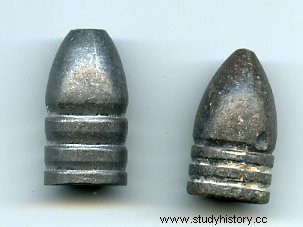
Minié ball, 1855
Different types of Minié balls. The four on the right have the Tamisier grooves to improve their aerodynamic stability
The Minié bullet is a type of muzzle-loading rifle bullet. This projectile differs from the spherical bullet in its ogive shape and the fact that it embeds itself in the grooves of the barrel and is therefore stabilized by the rapid rotation imparted to it during its journey through the barrel. The Minié bullet is named after the name of its co-developer, Claude Étienne Minié, inventor of the Minié rifle. She rose to prominence during the Crimean War and the Civil War.
Design
The Minié bullet was a cylindrico-conical lead bullet, of a caliber slightly smaller than that of the barrel of the weapon for which it was intended. It had at its base four outer grease-filled grooves and a conical hole at its base. As designed by Minié, the bullet had an iron lug at its base in order to advance the bullet and, under the pressure of the gases, to seal it by filling the space between the bullet and the barrel, allowing it to come into contact with its rifling.
The ancestor of the Minié ball was created in 1848 by French army captains Montgomery and Henri-Gustave Delvigne. Their design was made to allow rapid loading of rifles through the muzzle, an innovation that led to its widespread use as a mass battlefield weapon. In 1826, Delvigne had invented a bullet that could pack and expand to mold the grooves of the gun barrel. The cylindrical-conical bullet nose design was proposed in 1832 by Captain John Norton, but was not adopted.
Usage
The bullet could be quickly removed from the paper cartridge, the powder poured into the barrel and the bullet loaded through the muzzle and tamped with a ramrod against the bottom of the barrel. The packing made it possible to pack the powder, but also to deform the ball to put it in contact with the grooves of the barrel. Thus when the shot was fired, the bullet rotated on itself, acquiring better accuracy, but also, due to the improved seal, greater muzzle velocity and better range. It also allowed to clean the barrel of residues.
Efficacy
In 1849, a test trial at Vincennes demonstrated that at 15 m, the Minié bullet could penetrate two planks of poplar wood, each 17 mm thick and 50 cm apart. Soldiers at the time spread the rumor that at 1,100m the bullet could pass through a soldier and his backpack and kill anyone standing behind him, while at very close range it could pass through 15 people standing one behind the other.
History
The Minié bullet had a limited diffusion during the Crimean War, but later weapons derived from the Minié bullet were the most common weapons during the Civil War. Adopting this ammunition allowed soldiers to reload their rifled guns faster and fire more accurately. This has resulted in increased lethality of weapons used on the battlefield and rendered classic line infantry tactics obsolete.
The United States government adopted the Minié ball before the Civil War, with some modifications. The baseskirt was slightly thinner and the lug was removed, as the throttle pressure alone was enough to distort the skirt and overmold the scratches. Additionally, bullets adopted by the United States government had only three grease-filled outer grooves, instead of four.
Like the spherical bullet of smoothbore weapons, the Minié bullet produces terrible wounds. Large caliber bullets easily shatter bones, and in many cases the surgeon would amputate the affected limb rather than risk an often fatal secondary infection. Due to the increased accuracy of these bullets fired from rifled guns, the Civil War and to a lesser extent the Crimean War resulted in massive casualties, far greater than in previous conflicts.
